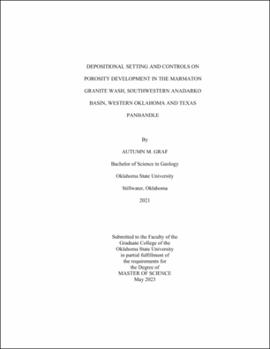| dc.contributor.advisor | Puckette, James O. | |
| dc.contributor.author | Graf, Autumn M. | |
| dc.date.accessioned | 2023-08-25T20:06:03Z | |
| dc.date.available | 2023-08-25T20:06:03Z | |
| dc.date.issued | 2023-05 | |
| dc.identifier.uri | https://hdl.handle.net/11244/338918 | |
| dc.description.abstract | The Middle Pennsylvanian (Desmoinesian) Marmaton Granite Wash is a tight gas sandstone reservoir in western Oklahoma and the Texas Panhandle that can economically produce natural gas, condensate, and natural gas liquids (NGLs). Despite being developed for years using vertical wells with varying degrees of success, the constituent low-permeability arkosic sandstones and conglomerates have become a significant gas play due to recent advancements in both hydraulic fracturing and horizontal drilling. Examination of the depositional and diagenetic processes that influence porosity development leads to a better understanding of reservoir evolution and improves targeting wells for the Marmaton Granite Wash and similar tight gas sandstone reservoirs as a whole. | |
| dc.description.abstract | This study examined three Marmaton Granite Wash cores at variable distances from the Amarillo-Wichita Uplift source area: two in Buffalo Wallow Field in Hemphill County, Texas (Dominion Grant Meek #236-1 and Fillingim #88-2) and one in Roger Mills County, Oklahoma (Laredo Kicking Bird #1-20). Sedimentary and biogenic structures as well as grain size trends in core were compared to wireline log data. Thin section analysis, scanning electron microscopy (SEM), and x-ray diffraction (XRD) were conducted to examine variations in depositional and diagenetic features and their effects on porosity development. Cross sections as well as structure and thickness maps were constructed to understand depositional trends by dividing the formation into distinct wash intervals using regionally-extensive shale markers. Porosity was not observed in thin section in Kicking Bird samples, but pores are evident in SEM images with sizes <10 µm and commonly <5 µm. The Buffalo Wallow wells displayed higher amounts of porosity and more evidence of dissolution. It is concluded that the abundant detrital clay matrix in the Kicking Bird protected grains from secondary porosity generation through dissolution. This study indicates that the wash in Buffalo Wallow wells was deposited in a middle submarine fan environment while the wash in the Kicking Bird well was deposited in a distal submarine fan environment and is likely too distal from the source area to possess ideal reservoir properties. | |
| dc.format | application/pdf | |
| dc.language | en_US | |
| dc.rights | Copyright is held by the author who has granted the Oklahoma State University Library the non-exclusive right to share this material in its institutional repository. Contact Digital Library Services at lib-dls@okstate.edu or 405-744-9161 for the permission policy on the use, reproduction or distribution of this material. | |
| dc.title | Depositional setting and controls on porosity development in the Marmaton Granite Wash, southwestern Anadarko Basin, western Oklahoma and Texas Panhandle | |
| dc.contributor.committeeMember | Hileman, Mary | |
| dc.contributor.committeeMember | Pashin, Jack | |
| osu.filename | Graf_okstate_0664M_18126.pdf | |
| osu.accesstype | Open Access | |
| dc.type.genre | Thesis | |
| dc.type.material | Text | |
| dc.subject.keywords | Anadarko Basin | |
| dc.subject.keywords | diagenesis | |
| dc.subject.keywords | marmaton granite wash | |
| dc.subject.keywords | porosity | |
| dc.subject.keywords | reservoir quality | |
| dc.subject.keywords | unconventional reservoir | |
| thesis.degree.discipline | Geology | |
| thesis.degree.grantor | Oklahoma State University | |
